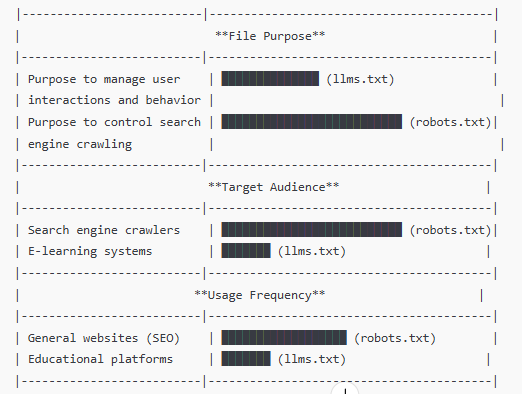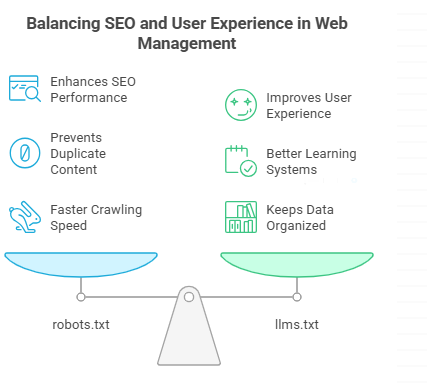- introduction: What Are Website Files and Why Do They Matter?
- What is robots.txt?
- What is llms.txt?
- Key Differences Between llms.txt and robots.txt
- Key Benefits of Using llms.txt and robots.txt
- Benefits of llms.txt:
- How to Set Up robots.txt and llms.txt
- Conclusion: Which File Should You Use?
- Popular Tools for Creating llms.txt
- Key Differences in Tools Usage:
- Ready to Take Your Website to the Next Level?
- FAQ about robots.txt and llms.txt
- What is the purpose of robots.txt?
- What is llms.txt and why is it important?
- How is llms.txt different from robots.txt?
- Do I need both llms.txt and robots.txt on my website?
- Can I create my own robots.txt file?
- Can llms.txt be customized for different learning platforms?
- How can I test if my robots.txt file is working correctly?
introduction: What Are Website Files and Why Do They Matter?
If you own a website, you’ve probably heard about files like robots.txt. But did you know there’s also something called llms.txt? These two files have different purposes, but they often confuse website owners.
In this article, we’ll explain the difference between llms.txt and robots.txt in a simple way. We’ll also show you why it’s important to know the difference, and how each of these files can help your website run more smoothly. Let’s get started!
What is robots.txt?
Robots.txt is a file that tells search engines (like Google or Bing) how to crawl or read your website. It’s like giving instructions to a robot on where it should and shouldn’t go on your site.
For example, if you have a page you don’t want to show up in search results, you can tell search engines not to visit that page. Here’s what it might look like:
User-agent: *Disallow: /private/
In this case, the “*” means it applies to all search engines, and “Disallow: /private/” means they shouldn’t visit the “/private/” folder.
What is llms.txt?
Now, let’s talk about llms.txt. This file isn’t as well-known as robots.txt, but it’s very important for websites that have learning management systems (LMS) or track user behavior for educational purposes.
So, what does llms.txt do? It helps websites manage data, track user actions, and organize educational content. If your website has online courses or learning tools, llms.txt can help make sure everything runs smoothly by keeping track of how users interact with the site.
Key Differences Between llms.txt and robots.txt

1. Key Differences between llms.txt and robots.txt?:
| Feature | llms.txt | robots.txt |
| Purpose | Manages how learning management systems (LMS) track user interactions and educational content. | Instructs search engine crawlers on which parts of the website should or shouldn’t be crawled. |
| File Usage | Used by websites with online learning systems. | Used by most websites for search engine optimization (SEO). |
| Main Audience | Learning management systems, e-learning platforms. | Search engine crawlers (Googlebot, Bingbot, etc.). |
| Scope of Control | Controls data flow related to user interactions, educational content, and tracking behavior. | Controls which pages or sections of a website are accessible to search engine bots. |
| Data Management | Manages how user actions and learning data are tracked across courses and materials. | Doesn’t deal with user data, focuses only on search engine access. |
| Example Use | A school website telling an LMS to track user progress on online courses. | A business website blocking search engines from indexing a “private” section. |
Let’s compare these two files side-by-side to make things clearer:
-
Purpose:
- robots.txt: Used by search engines to know which parts of your website they should or should not visit.
- llms.txt: Used by learning systems or educational tools to track how users interact with content on your site.
-
File Usage:
- robots.txt: Every website uses it if they care about SEO (Search Engine Optimization).
- llms.txt: Only websites with online learning systems or user tracking tools would use this file.
-
Audience:
- robots.txt: Targets search engine bots like Googlebot.
- llms.txt: Targets learning management systems (LMS) or educational platforms.
-
Function:
- robots.txt: Controls which pages or parts of your website should be crawled by search engines.
- llms.txt: Helps track how users learn or interact with online content.
is llms.txt and robots.txt used for different purpose?
You might be asking, Why does it matter whether I use robots.txt or llms.txt? Well, it depends on your website.
- If you want to improve your SEO and make sure Google indexes the right pages, you definitely need txt.
- If you’re running an online learning platform or using user-tracking tools, txt is important for managing how your users interact with the content.
If your site has both, you might need to use both files to get the best results. Think of it this way: robots.txt helps with search engine visibility, and llms.txt helps with user experience and data management on e-learning websites.
Key Benefits of Using llms.txt and robots.txt

Benefits of robots.txt:
- Helps with SEO: It ensures that search engines only index the most important pages.
- Prevents Duplicate Content: Blocks search engines from crawling unnecessary duplicate pages.
- Faster Crawling: Helps search engines focus on the pages that matter most, improving website speed.
Benefits of llms.txt:
- Improves User Experience: Helps track how users interact with courses or content.
- Better Learning Systems: Ensures learning platforms work properly by directing data flow.
- Keeps Data Organized: Helps manage the large amounts of data in educational systems.
How to Set Up robots.txt and llms.txt
If you want to set up these files, here’s how:
For robots.txt:
- Create a text file called txt.
- Add rules like “Disallow” or “Allow” to control search engine access.
- Upload the file to your website’s root folder (for example: https://www.acsius.com/robots.txt).
For llms.txt:
- Make sure your site uses a learning management system (LMS) or tracking tool.
- Create an txt file with the correct tracking instructions.
- Upload it to your website’s root folder.
Conclusion: Which File Should You Use?
To wrap things up, it’s clear that robots.txt and llms.txt serve different purposes. If you’re focused on SEO and improving search engine rankings, robots.txt is a must. But if you’re running an online learning platform or managing user data, llms.txt is the file you need.
At ACSIUS, we help businesses like yours understand how to use these tools effectively. Whether you’re optimizing for search engines or improving the user experience on your site, knowing when and how to use robots.txt and llms.txt will make a big difference.
Popular Tools for Creating llms.txt
Unlike robots.txt, llms.txt is not a standard or widely used tool like robots.txt. However, tools and platforms that manage Learning Management Systems (LMS) often provide ways to integrate or customize the llms.txt file.
-
Moodle (LMS):
- Purpose: Moodle is a widely used open-source Learning Management System. While Moodle doesn’t have a built-in llms.txt generator, administrators can configure how the platform interacts with user data, which may include modifying server settings that control user data flow.
- How to Use: You can customize Moodle’s settings to manage user tracking, which would influence the contents of the llms.txt file.
-
TalentLMS:
- Purpose: TalentLMS is another e-learning platform that provides robust data tracking and user management. If you’re integrating a learning system with a website, you might be asked to provide specific configuration files (including llms.txt) for tracking user progress.
- How to Use: Typically, these files are manually created based on your LMS setup or can be auto-generated depending on the platform.
-
Custom Code for Learning Platforms:
- Purpose: If you’re using a custom-built Learning Management System or integrating e-learning tools into your website, you might need to create an llms.txt file manually. This would involve writing specific tracking rules for your platform.
- How to Use: Work with developers or use a simple text editor (like Notepad++) to create and upload the llms.txt file to the root directory of your website.
-
LearnDash (for WordPress):
- Purpose: LearnDash is an LMS plugin for WordPress. It helps with creating courses, managing users, and tracking progress. You might need to add configuration settings to a custom llms.txt file if you’re integrating third-party tracking systems.
- How to Use: Similar to Moodle, if using third-party systems, you’ll need to create and upload the llms.txt manually with the appropriate user data and tracking rules.
Manual Creation (For Both Files)
- Text Editors: If you’re familiar with basic code and file management, you can simply create both robots.txt and llms.txt files using any text editor (like Notepad, TextEdit, or VS Code). After writing the appropriate rules and data, just upload the files to your site’s root directory.
- For robots.txt: Write rules for search engines (e.g., Disallow: /private/ or Allow: /public/).
- For llms.txt: You would add tracking data or user management rules based on your e-learning system.
Key Differences in Tools Usage:
| Tool | robots.txt | llms.txt |
| Google Search Console | Used for testing and validating robots.txt. | Not applicable for llms.txt. |
| Yoast SEO | Automatically generates robots.txt for WordPress sites. | Not used for llms.txt generation. |
| Moodle/TalentLMS | Doesn’t generate robots.txt, but can configure SEO. | Can integrate with learning management data, potentially using llms.txt. |
| Custom Development | Can be manually created using text editors. | Requires manual creation, especially for custom LMS setups. |
| Online Generators | Multiple tools available like SEO Tools or Small SEO Tools. | Very few tools; often requires manual creation or system-specific setups. |
- robots.txt is widely used, and there are many online tools like Google Search Console, Yoast SEO, and SEO robots.txt generator to help you create and manage this file.
- llms.txt, however, is more niche, and tools are less common. Platforms like Moodle, TalentLMS, and LearnDash might require manual setup, or custom code if you’re working with a specific Learning Management System.
Ready to Take Your Website to the Next Level?
If you want to learn more about website optimization or need help with SEO, visit ACSIUS. We’re here to help you improve your website’s performance!
FAQ about robots.txt and llms.txt
What is llms.txt and why is it important?
llms.txt is a file used by websites with Learning Management Systems (LMS). It helps manage how user interactions, learning content, and tracking data are handled. It’s essential for ensuring smooth tracking of educational content and user progress.
How is llms.txt different from robots.txt?
While robots.txt is used to control how search engine bots crawl a website, llms.txt is used to manage user data and interactions on learning platforms. robots.txt deals with SEO, whereas llms.txt is focused on user experience and learning management systems.
Do I need both llms.txt and robots.txt on my website?
If your website has a Learning Management System (LMS), you might need llms.txt to manage user interactions. For SEO purposes, you'll also need robots.txt to guide search engine crawlers. Both serve different functions, so using both is beneficial if your website requires them.
Can I create my own robots.txt file?
Yes, you can create your own robots.txt file using a simple text editor (like Notepad). Once created, you can upload it to your website’s root directory to control how search engines access your site.
Can llms.txt be customized for different learning platforms?
Yes, llms.txt can be customized depending on the learning platform you use (like Moodle, TalentLMS, or custom LMS). The file is typically tailored to how your platform tracks user progress and interacts with educational content.
How can I test if my robots.txt file is working correctly?
You can test your robots.txt file using tools like Google Search Console’s robots.txt Tester. This tool allows you to simulate how Googlebot will interact with your site based on your robots.txt rules.





